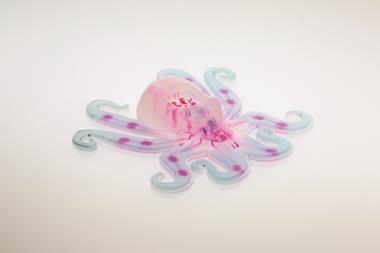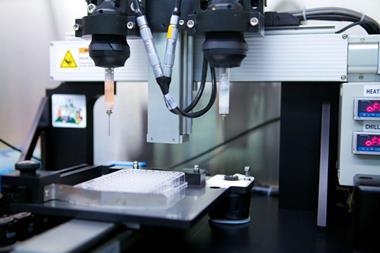A multi-layered, jumping robot has been manufactured using a 3D printer
Although they may not be taking over the world any time soon, a 3D printed soft robot mimicking the flexible body of an invertebrate has been manufactured by a group of scientists in the US. The production of the bio-inspired robot in this manner may help to usher in a new era of soft robotics.
Since the production of the first automated machine in 1954 by George Devol, robots have transformed how industries carry out hazardous manufacturing operations. But this remains a far cry from the conventional perception of what a robot is.
‘When people think of robots, they naturally go towards humanoid, hard robot systems because this is really what we’ve come to associate robots with,’ explains Adam Stokes, a robotics expert from the University of Edinburgh, UK, who was not involved in the work. ‘But, there’s a whole world of robots we don’t really see – service robots, things that are used in factories [to] pick things up and move things around.’
There is a limit to the tasks these robots can perform however, as they are made from hard and rigid materials. Stokes goes on to explain that in applications outside of industry, robots will need to be flexible and adaptable in a wide array of environments, but also safe for human interaction.
Nicholas Bartlett and his colleagues at Harvard University have now provided a new avenue for soft robotics manufacturing by 3D printing a multi-layered robot using acrylic. Thanks to the the way the robot is produced the shell gradually transitions from hard to soft. This is because the printer can produce multiple layers of material that each has a different stiffness, allowing any robot produced to effectively absorb damage and mimic biological organisms with a flexible exterior.
The double-layered hemispheroid robot the team produced has a rigid central core, which houses a small tank holding oxygen and butane. The ignition of these gases results in the bottom layer of the robot ballooning outwards to provide the necessary propulsion to lift the device off the ground and the variable stiffness of the top layer allows it to land safely. With pneumatic legs to direct the direction of travel before lift-off, the robot can jump up to a height of 0.76m.
During this process the robot is not attached to anything and is capable of carrying out the task on its own – an advantage that has impressed Stokes. ‘It’s a big improvement on the previous work, because they’ve managed to make this fully untethered system,’ comments Stokes. ‘It takes soft robots one step further from being in the lab to being out [of it].’
Gursel Alici, a roboticist from the University of Wollongong, Australia, agrees with Stokes, but is reluctant to call the device a robot. ‘It has not been demonstrated to be a reprogrammable … and multi-functional device, which connects sensing to an action,’ says Alici. ‘This study, however, successfully translates some soft robotic concepts … into reality.’












No comments yet